Vinton Cerf - Columbus, who opened the Internet
The feeling that all the knowledge of the world is under the pads of your fingers is truly wonderfulModern Columbus, one of those whose name is associated with the discovery of the century - the world wide web the Internet. He is the one who developed the TCP / IP protocol, thereby allowing hundreds and thousands of servers to communicate with each other, while providing access to information for millions of people, although quite recently it looked a little like reality. Who is the genius of modernity, who embodied the seemingly things that were beyond fiction?

Vint Cerf is the creator of the TCP / IP data transfer protocol, the patriarch of the Internet, the chairman of the International Corporation for the Distribution of Names and Numbers on the Internet (ICANN), the vice president of Google Inc., an American programmer, a computer scientist, a mathematician. His contribution is hard to overestimate. Screw was repeatedly awarded honorary scholarships and awards; the National Medal of Technology, the Presidential Medal of Freedom and the Turing Award are kept in his “bins”. In 1992, this amazing man founded the Internet Society (ISOC) / Internet Society. Working at MCI, Screw was involved in the creation of the first commercial email system (MCI Mail) connected to the Internet. He is the author of many predictions concerning the role of modern technology in the future of mankind.
You create your own world, and you own this world. The computer will do whatever you program. You are dealing with a wonderful sandbox in which every grain of sand is under your control.
Little biography
Vint Cerf, his full name is Vinton Gray Surf, born June 23, 1943 in New Haven (Connecticut, USA). His father was an aeronautical engineer, he worked in the Rocketdyne company for the production of rocket engines. School years Cerf spent in the suburbs of Los Angeles, Van Nuys, and then enrolled at Stanford University. During his studies, Serf showed inclinations toward mathematics. Already at that time he began to develop an interest in computers. He was attracted and fascinated by science fiction, especially the works of Ray Bradbury and Hall Clement.
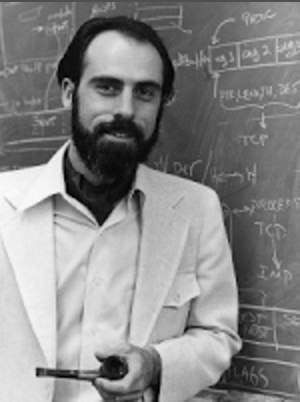
In 1965, Vint received a bachelor's degree in mathematics. In 1965-1967 he worked at IBM, in 1967-1972 - at the University of California, Los Angeles. Here in 1970, Cerf received a master's degree in computer science, and in 1972 he defended his doctoral thesis.
At the University of California, Cerf began work on creating the immediate predecessor of the Internet, the ARPANET network.
In 1969, the United States Department of Defense decided to create a reliable information transfer system in case of war. The Advanced Research Projects Agency (ARPA) has taken on the development of a computer network for this. The development of such a network was entrusted to the University of California at Los Angeles, the Stanford Research Center, the University of Utah and the University of California at Santa Barbara.
October 29, 1969 at 21:00 was conducted the first test. The network consisted of two terminals, they were as far from each other as possible. One of the terminals was located at the University of California, and the second at a distance of 600 km from it - at Stanford University. The terminals used Honeywell DDP-316 16-bit minicomputers with 12 KB of memory. 56 kbps lines of communication were rented from the AT & T telephone company. The software consisted of IMP-host connections, IMP-IMP-protocol, IMP-sender-IMP-recipient protocol (IMP-s-IMP-r). The task was as follows: the operator at the first terminal entered the word “LOGIN”, and the operator at the second terminal had to confirm that he could see the given set of letters on his screen. The network got its name ARPANET. Four scientific institutions were merged under the project.
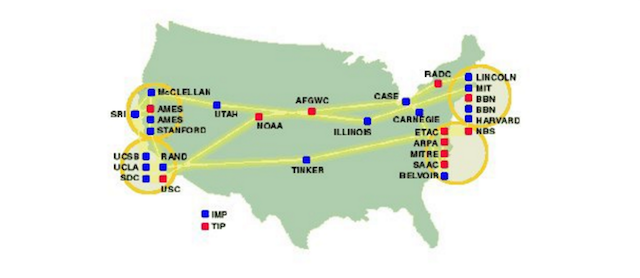
ARPANET card, 1972
In 1970, Cerf began working with the second “father of the Internet” Robert Kahn under this project.
“I am not the father of the Internet. Bob Kahn invited me to participate in the program, which he started while working at DARPA. We worked very closely together to develop the basic structure of the Internet. Therefore, it seems to me honest to consider us both the fathers of the Internet. ”
The role of Vinta Cerfa was mainly in the development of protocols, together with Stephen Crocker. Together with Robert Kahn, Screw developed TCP / IP protocols and wrote software to evaluate the performance of ARPANET. At the time, Cerf was a UCLA graduate, while working in the laboratory of Professor Lena Kleinrock, who was engaged in a thesis on packet switching. Leonard Kleinrock connected the first two ARPANET nodes, the forerunner of the Internet, and created the “host-to-host protocol” for ARPANET.
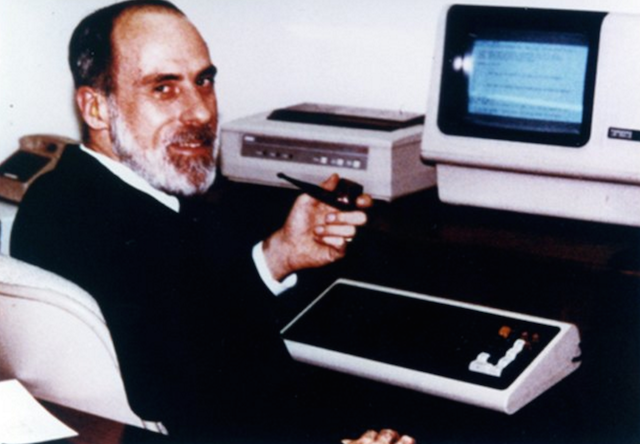
In 1972, Cerf returned to Stanford University, where he received a position as assistant professor. Surf continued to work with Kahn. In 1973, Kahn realized that the NCP protocol was outdated and asked for help from Surf. In 1974, they published the article “Protocol for Packet Internetworking Communication”; the article described the TCP data transfer protocol, which allows data to be transferred between different networks. That is why Surf and Kahn called the fathers of the "Internet".
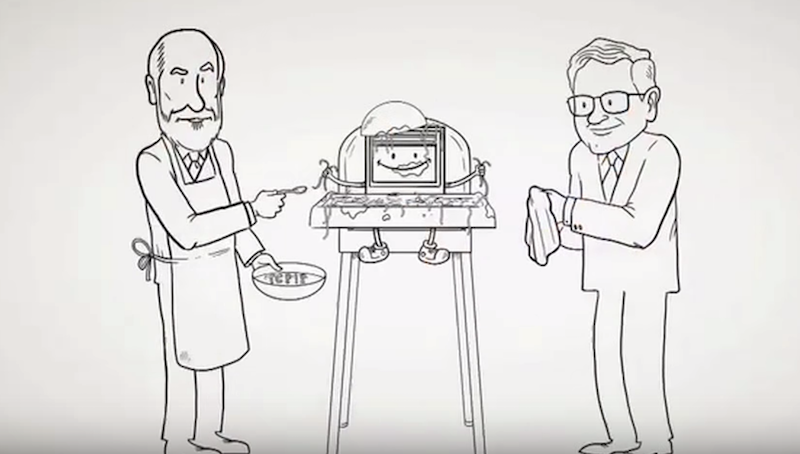
In 1976, Screw began working in the Defense Advanced Research Projects Agency of the US Department of Defense. Here Surf and Kahn devoted themselves to the development of data packet and security technologies. In 1978, the previously developed data transfer protocol was divided into two parts - TCP and IP. The TCP / IP protocol stack is still the standard for transferring data on the Internet. In 1983, the TCP / IP protocol suite was used by the ARPANET network, and later by the Internet, after ARPANET ceased to exist in 1990. While continuing his research at Stanford, Cerf was a project manager at DARPA.
In 1982, Cerf retired from DARPA and, until 1986, served as vice president at MCI. MCI is a US telecom operator and the owner of the largest Internet network. Cerf led the development of MCI Mail, the first commercial email service associated with the Internet.

In 1986, Surf left MCI, moved to the Corporation for National Research Projects (CNRI) created by Kahn, where he worked on information infrastructure issues, worked on the creation of an electronic library and other Internet projects. In 1994, Cerf nevertheless returned to MCI as chief vice president. At the same time he worked as a senior vice president of WorldCom Internet Architecture and Technology (1998-2002). From 1999 to 2007 he was a member of the Board of Directors (ICANN). He worked at MCI until 2005, this year he went to work at Google.
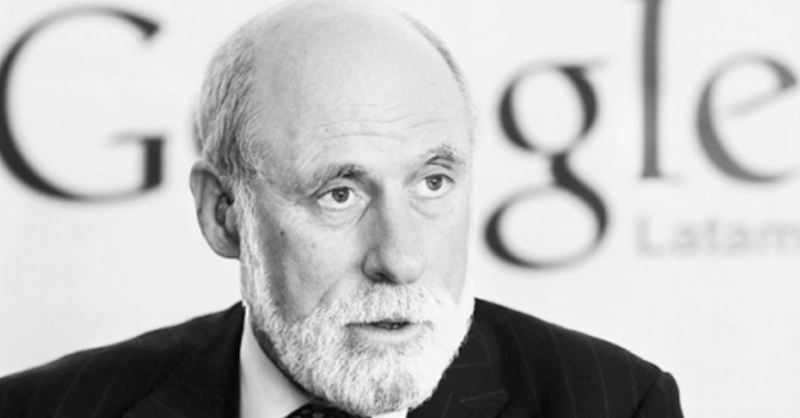
As mentioned earlier, in 1992 he became one of the founders of the Internet Society (Internet Society, ISOC), in 1992-1995 he was its president, in 1998-1999 the chairman of this society. This is a non-profit organization that unites more than a hundred technology companies and stands for the controllability of the Internet by users and its openness.
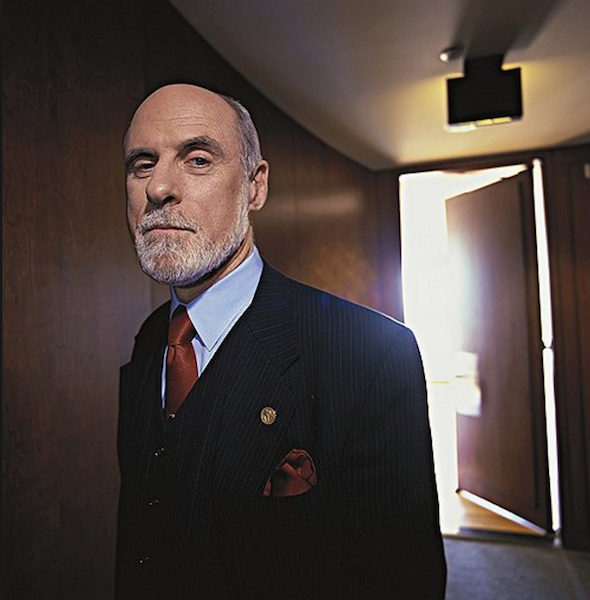
In 2000, Surf became the second chair of the ICANN international organization. ICANN - International Corporation for the Distribution of Names and Numbers on the Internet. Until 2007, Screw remained in this "rank." As a leader, Surf was accused of an overly conservative policy and lack of support for the internationalization of the Internet, although during Vint's work, ICANN's staff grew from about ten times, initially the organization had a dozen employees, and the budget grew from 3.78 million dollars in 2001 to 41 million dollars in 2007. New Zealander Peter Dengate Thrush in 2007 took the post of Screw. After that, Cerf announced that he was not going to continue to do anything for ICANN. While Cerf was chairman of the ICANN board of directors, he proved himself to be a supporter of the introduction of non-Latin fonts. Such an attempt was made in 2003, but the rules turned out to be so heterogeneous that intruders could take advantage of them. Due to the fact that some of the letters in Cyrillic, Greek and Latin look the same, there could be a threat of phishing. The company with the Surf at the head worked on new rules that should have excluded such cases.
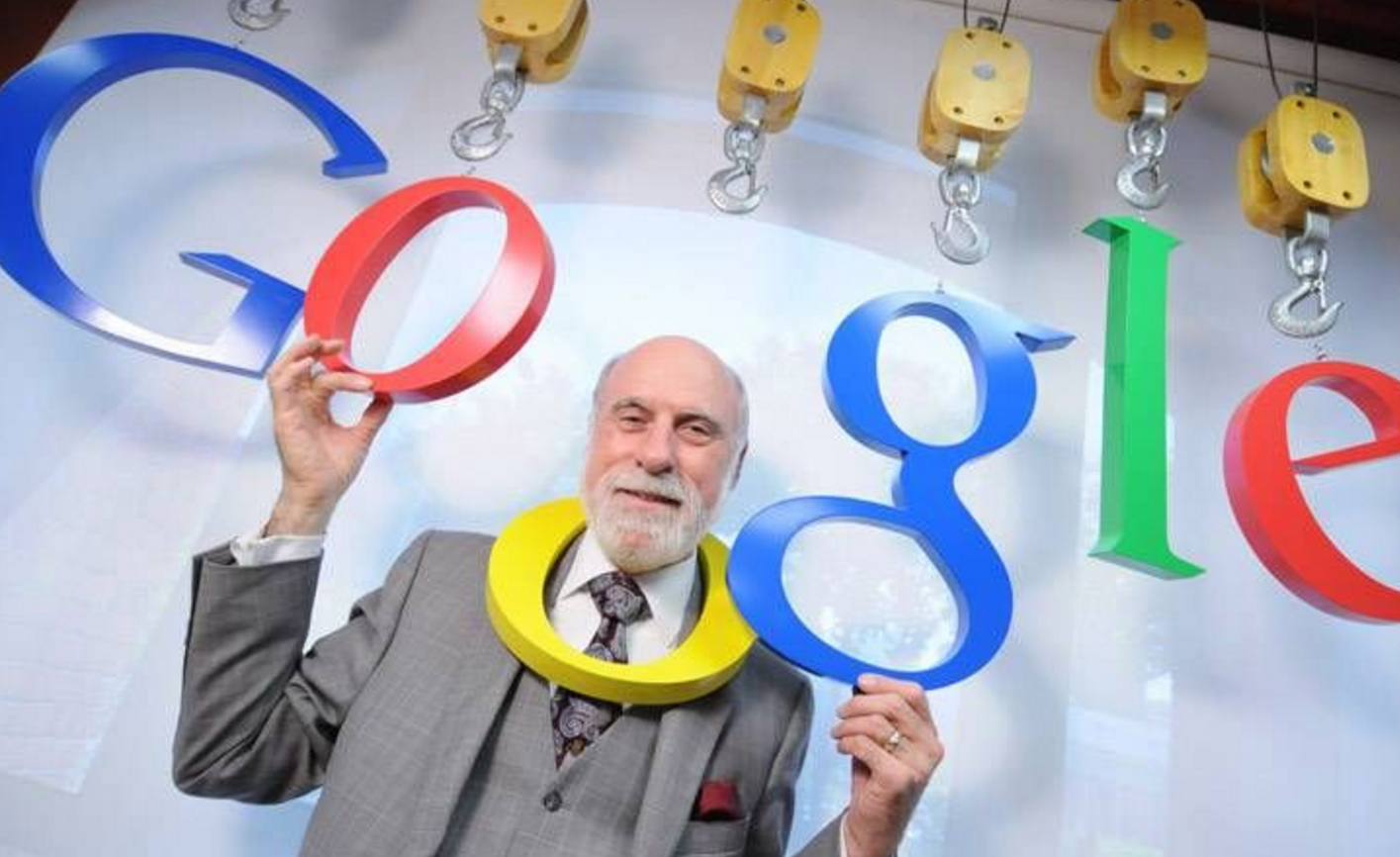
In 2005, Google CEO Eric Schmidt invited Surf, the company was just looking for intellectuals to help it take a leading position in the global market. In 2005, it employed 4,200 people. Vint Cerf became the vice president and the so-called “main internet preacher” of Google. Surf had a task to develop network infrastructure, to be responsible for identifying new technologies that promote the development of the company's products.
Cerf also participated in a number of innovative projects. In particular, since 1998, he collaborated with NASA's Jet Propulsion Laboratory in a project to create the so-called interplanetary Internet, one of the means of communication in outer space. While still in high school and college, Screw worked part-time at Rocketdyne, which was producing rocket engines. He analyzed rocket engine tests. After Rocketdyne, he also worked in the North American Aviation Space and Information Systems division. The experience gained there was useful to Vint Cerf in 1998, when he and his friends decided to think of a way to expand the Internet so that it would work throughout the solar system. They began to develop the interplanetary system in the Jeffrey Paulson Laboratory in California. Thinking that in the future they will be sending not only people, but also robots with equipment controlled from the Earth into space, and the astronauts will be able to communicate with each other and get access to a large Internet. A group of researchers has been approved by NASA to test the interplanetary system, which took place in November 2008. The purpose of the tests is to define more precisely what the Internet protocols for space should be.
In 1997, Surf and Kahn as creators of TCP / IP were awarded the National Medal for Technology, in 2004, Surf and Kahn were awarded the Turing Award, in 2005 they were awarded the highest civilian award of the United States - the Presidential Order of Freedom in information technology.
A bit of personal life
In 1965, Vinton Cerf met his future wife, they were introduced to the head of the hearing aid group. Sigrid lost her hearing at the age of 3, and Screw suffers from partial hearing loss. Sigrid invited Surf to the Los Angeles Museum of Art to show her favorite pictures to her new acquaintance. A year later, they legalized their relationship. She managed to instill in her husband a love of art, he collects stamps, coins, wine, collects sculptures, drawings of alligators and crocodiles, likes to go to the theater. Prefers classical music: Wagner, Beethoven, Bach, Mozart.
The family of Winton has two sons, David and Bennett. At the moment, their activity is associated with the introduction of computer technology in film and video production.
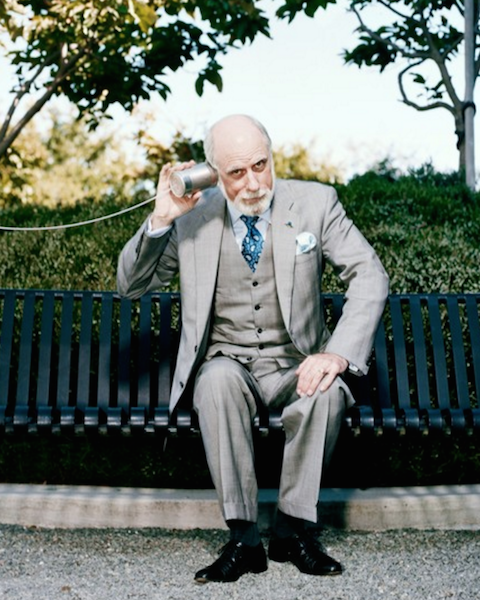
Vinton Cerf was at the very beginning of the creation of the Internet, but he could not have imagined what the results of the existence of the Network and its use by humanity would lead to. ... “When we launched the Internet in 1983, the powerful handheld computer was science fiction. However, the Internet has evolved even beyond the limits of cell phones and now has incorporated the sphere of smart objects that are able to communicate both with you and with each other. These devices, collectively called the Internet of Things, now need their own standard protocols that allow products from different companies to work in unison. "
The Internet is constantly evolving. 40 years ago I was in graduate school at California University of Technology and was working on software for connecting a computer called Sigma-7 to the first node of the ARPANET network. This network was created by the US Department of Defense for an experiment on testing packet switching technology. In 1979, people thought packet switching was a stupid idea. Communication then worked on other principles, and telephone companies believed that the US was not interested in such technology.
Over the next 30 years, the Internet has grown to gigantic proportions, but basically it has remained a network of networks: independent, decentralized.
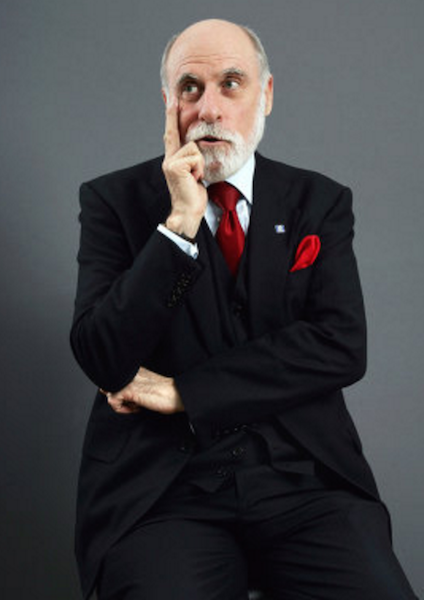
When asked if he would change if he could turn back time, Screw replied that he would not allow a couple of serious errors related to the choice of the number of values for the address space in the network. At that time in 1974 it was just an experiment, someone suggested using 128-bit addresses, but the question was why so much? .. But the experiment was not over, there was a need to introduce IPv6, with 128-bit address space. The second issue that worries Screw - is the security of data transmission in the network.
Surf is an honorary doctor of many other institutes and universities, the author of many works that affect both private issues of Internet technologies, and general issues of the development of the Internet.
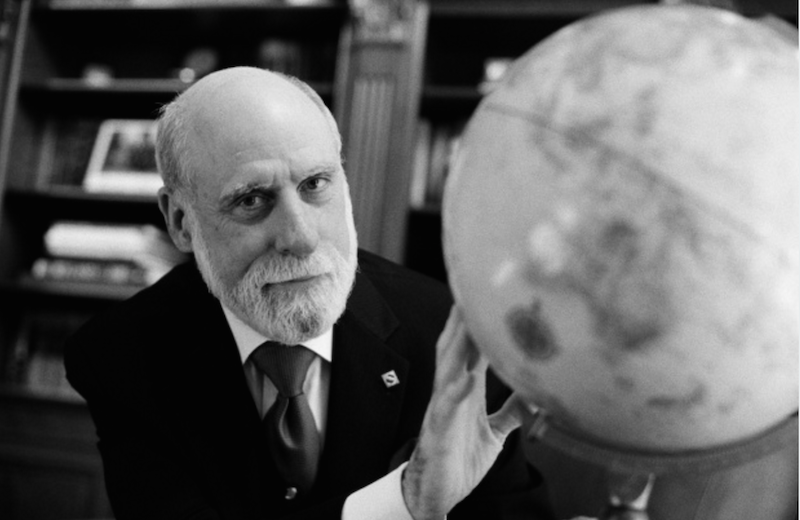
According to Cerf: Sigma-7 has long been at the museum, and some believe that I should also be there with her. Now he spends a lot of time working on the development of an idea about the interplanetary Internet. According to Cerf, the interplanetary Internet will provide uninterrupted communication with space, which will lead to lower costs and increased bandwidth. NASA and the largest authorities in the field of network development work together to expand the boundaries of the Internet and its release in the coming years to other worlds. The irresistible speed of light stands in the way of the free travel of the Internet of the new generation. 55 million kilometers between Earth and Mars, even at the speed of light, radio signals will cover this distance in 3 minutes, but the distance between two planets is constantly changing, the time to overcome can take up to 20 minutes.
To cope with the delays and violations that occur in space, we will need clear and strict protocols. I participated in the development of a new “packet protocol”, which is based on the assumption that communication will be interrupted at some moments. When this happens, it saves data packets and waits for the connection to be restored. The United Nations is currently in the process of adopting this protocol as a standard that will provide guided and robotic deep-space missions. We initially designed the Internet as a network of networks that can grow and expand over time. So he became. And so it will continue. "As history shows, nothing stands still ... Perhaps now is the time to book yourself a new address: yourname.mars?)
